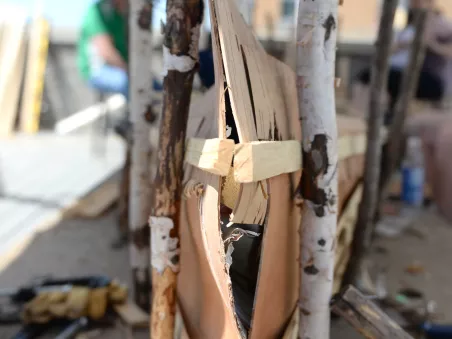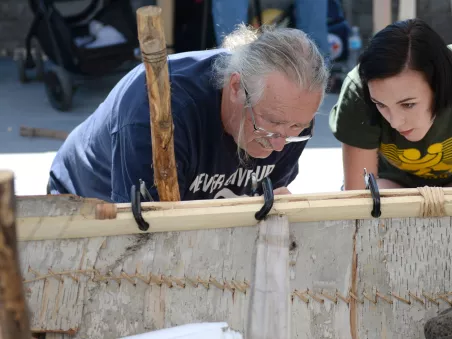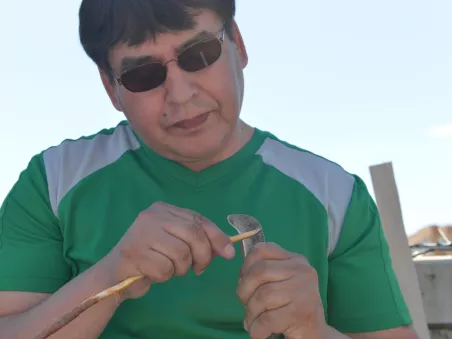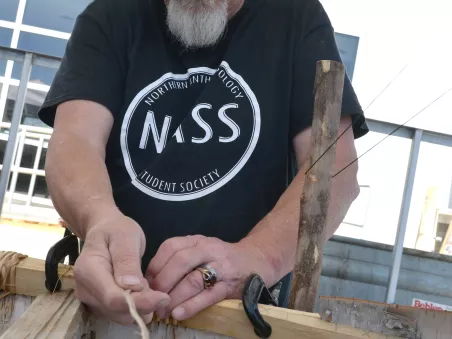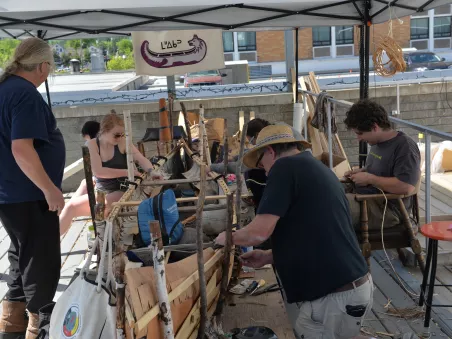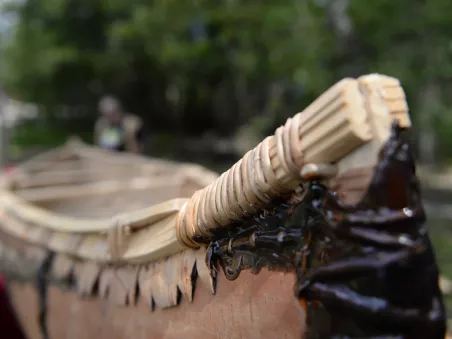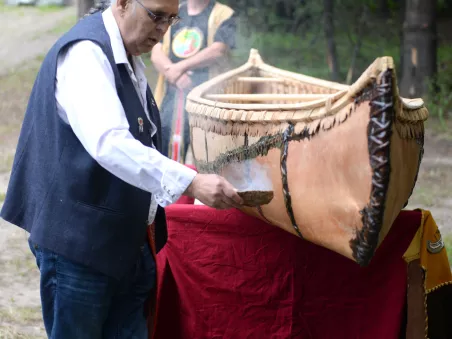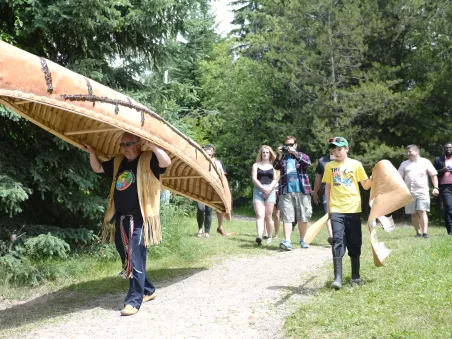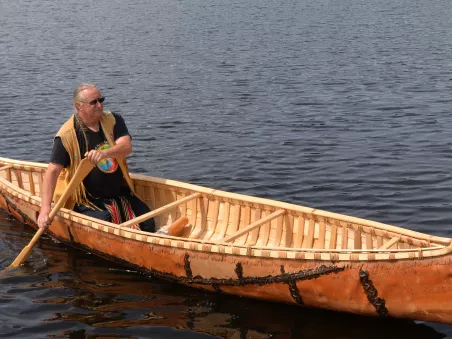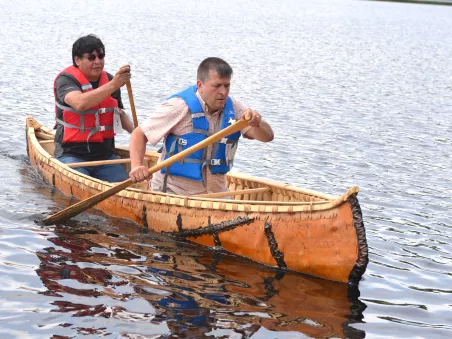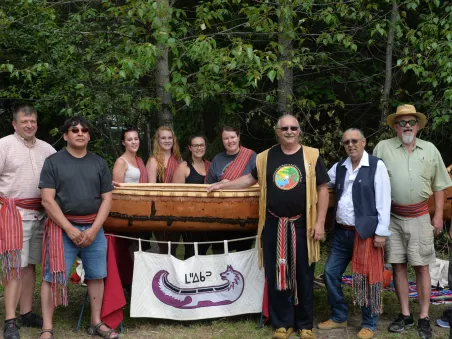Students Send a Message with Handmade Birch Bark Canoe
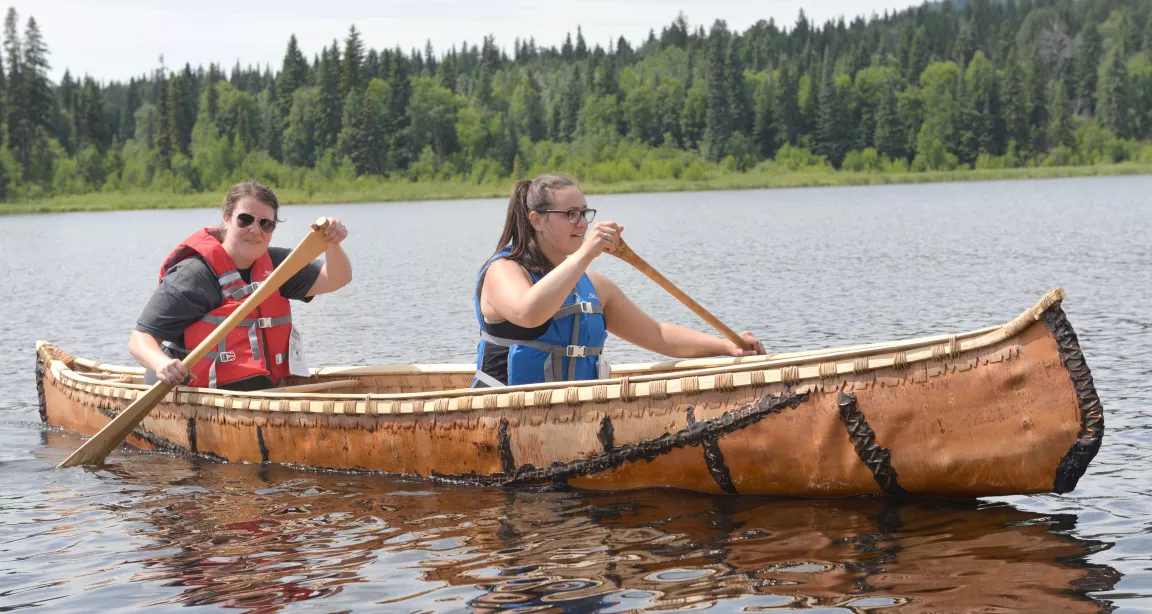
University of Northern British Columbia student Jacey Wolfe felt a sense of pride as she watched a birch bark canoe glide through the water on Ferguson Lake.
Built by Wolfe and her classmates as part of an experiential learning field school, the canoe floated gracefully as a symbol of collaboration, cultural identity and shared history.
“To know that our canoe actually floats and we all did it as group, it is a great feeling,” Wolfe says as she watched her classmates take turns paddling the canoe.
Students in the field school combined classroom teaching on Cree and Métis culture and the history of French-speaking people in Northern British Columbia with the hands-on process of building of the canoe.
The project began with a desire by Le Cercle des Canadiens Français de Prince George to use the 150th Anniversary of Canadian Confederation to explore further the history of French-speaking people in Northern British Columbia. They secured a grant from Heritage Canada to begin the project and collaborated with UNBC and Two Rivers Gallery to deliver it.
The field school consisted of three courses: two in the classroom at UNBC and one at Two Rivers where the canoe was constructed.
“The process of building the canoe gave the students insights into what it would have been like in the 19th century in Fort George,” says UNBC Anthropology Professor Dr. Michel Bouchard. “Building a canoe is a different type of knowledge and it helps you better appreciate what you are learning in the classroom.”
Bouchard taught one of the classroom courses which delved into the historical relationship between French-speaking people and Indigenous people in Northern B.C., dating back to before Confederation.
“If you had gone to Fort George in 1867, almost everyone would have been speaking French,” Bouchard explains. “The men who were working, the labourers and voyageurs, were largely French-speaking Iroquois, Canadiens and Métis. Even the Scottish bosses would have spoken French.”
Expert birch bark canoe builder Marcel Labelle came from Mattawa, Ont., to teach the hands-on portion of the class. Under Labelle’s tutelage, students learned every step of the process: from finding roots to be used to attach parts of the canoe together, to stitching the birch bark, to splitting the sheathing by hand, to sealing the canoe with spruce gum.
“In building the canoe, the students realized it is a complex process,” Labelle said. “A birch bark canoe is a piece of engineering that is quite advanced.”
During the canoe’s construction, students from French Immersion and Francophone schools in Prince George visited Two Rivers to see how it was being built and learn about its significance.
“We wanted to inform the young children about the history of the Métis and French-speaking community and their impact on the history of British Columbia,” says Jeff Nze Memiaghe, executive director of Le Cercle des Canadiens Français de Prince George.
The canoe also sends a message.
Labelle said the name of the canoe, The Indian Act 2017, is a reflection of the ongoing project of Canada. The Indian Act, he says, is rooted in our history, but is something that needs to be improved upon.
“This group will be carrying the message of this canoe forward,” Labelle said. “This canoe is a tool they can use to talk about the Indian Act and this beautiful craft will support them when they have those discussions.”
Métis Elder and UNBC instructor Earl Henderson echoed those thoughts. He taught the class on Cree and Métis culture and participated in the canoe’s construction.
Henderson said the birch trim along the side of the canoe is reminiscent of a heartbeat monitor.
“The canoe is a messenger and it holds the heartbeat of the nation,” Henderson says. “Wherever it goes spreading that message, the heartbeat is going to be there. The heartbeat is going to get stronger and it is going to help heal the communities that touch it.”
Most of the students in the class are Métis and Wolfe said the teachings had a special resonance.
“Learning about the Cree and Métis was very interesting because I have a lot of personal connections,” she says. “It was an honour to work with Marcel and his family. Some really great bonds were created among the students and instructors working together on the canoe.”
After the canoe was completed all of the students received sashes from the Métis Nation British Columbia.
The field school attracted students from a variety of degree programs at UNBC as well as a visiting student from the University of Victoria.
“The canoe building provided an awesome reference point for all of us,” says Wayne Nipshank, a Criminology graduate from SFU who was a student in the course. “The teachings of the canoe can be applied to all the different disciplines.”
With the canoe construction complete, Nipshank is already looking towards his next project.
“I really want to try building one of my own,” he says, before chuckling, “it was suggested I start off with a small one.”
